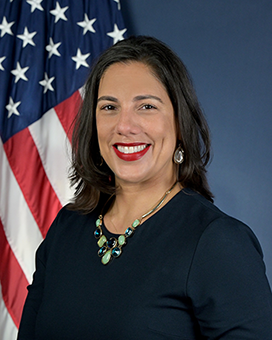By: Veronica Vanterpool, Deputy Administrator, Federal Transit Administration, U.S. Department of Transportation
For millions across the country, safe and reliable transportation to healthcare is critical, especially for people with disabilities. Without reliable transportation, older adults regularly miss critical medical appointments. Without a ride to the pharmacy, Americans without cars forgo taking essential medications.
To take on these challenges, the federal government has invested in providing transportation and mobility options for older adults facing challenges and is working to synchronize how federal programs can better meet their needs.
This year marks the 20th anniversary of the Coordinating Council on Access and Mobility (CCAM). The CCAM was established to improve access to transportation and mobility services, particularly for three populations: people with disabilities, older adults, and low-income individuals.
Led by the Federal Transit Administration (FTA), the CCAM consists of 11 members; and nine federal departments that fund 130 programs to advance human services transportation. Two agencies—the National Council on Disability and the Social Security Administration—also provide expertise to help the CCAM serve its targeted populations.
Together, for two decades and counting, the CCAM works to improve the availability, accessibility, and efficiency of human services transportation, which would not be possible without the U.S. Department of Health and Human Services’ (HHS) support and contributions. Thanks to HHS’ support, we celebrate the following accomplishments:
- Removing federal barriers to transportation coordination. Federal fund braiding for local matches allows grant recipients to use funds from one federal grant program to meet the match requirements of another. The Federal Fund Braiding Guide provides information on federal fund braiding for transportation-related projects. The guide was made possible by HHS agencies, including the Centers for Disease Control and Prevention (CDC), Administration for Community Living (ACL), and Administration for Children and Families (ACF)), which manage over 60 grant programs that may fund human services transportation in the CCAM Program Inventory. We are updating and consolidating the Federal Fund Braiding Guide and the CCAM Program Inventory in 2025.
- Collaborated with the HHS’ Centers for Medicare & Medicaid Services to publish a fact sheet to encourage more coordination between state departments of transportation, state Medicaid agencies, and other transportation entities interested in Medicaid non-emergency medical transportation (NEMT). State Medicaid agencies have flexibility in how they administer NEMT. As a result, solutions to Medicaid transportation challenges vary widely by state. Collaboration ensures providers have a shared understanding of what is allowable in their state.
- Developed guidance to improve transportation coordination between more than 130 programs that fund human services transportation. The guidance clarifies federal policies about sharing federally supported assets, such as vehicles and transit hubs, by another entity for non-transit purposes. This coordination can help bring medical professionals, medicine, and outpatient care directly to people’s homes or to accessible areas nearby. Several HHS agencies are included in FTA’s new incidental use of transit assets (vehicle sharing) guidance, including ACF, ACL, CDC, and HRSA.
- Launched the CCAM National Technical Assistance Center to promote and facilitate human services transportation, public transit, and non-emergency medical transportation coordination that improves access to everyday destinations in underserved communities. Of the seven CCAM members serving as guidance partners, four are from HHS: ACF, ACL, CMS, and HRSA. Collectively, they provide health-focused expertise regarding grant programs and resources. Stakeholders with transportation-related needs are eligible to receive technical assistance from the center.
- Created the CCAM Multisector Partner Directory to facilitate engagement between the diverse national associations, organizations, and technical assistance centers that play a role in improving the availability, accessibility, and efficiency of human services transportation. The resource lists organizations that have a relationship with, and/or are funded by, at least one CCAM member. More than 20 health-related partner organizations and technical assistance centers are listed in the directory, including the “Accessible Transportation Resource Center,” “Transit Planning 4 All” and the “National Center on Parent, Family, and Community Engagement.”
Interagency Activities
Each year, FTA provides community grants incentivizing local transportation partnerships through its national Technical Assistance centers. HHS networks may benefit from the FTA centers and their grant programs, listed below. If interested in locating and/or partnering with public transit in rural and Tribal communities, refer to the FTA-funded Community Transportation Database, which encourages transportation and health partnerships.
- The National Aging and Disability Transportation Center (NADTC) grants support communities in assessing local transportation needs and developing and implementing new models for increasing the availability of accessible transportation services for older adults and people with disabilities.
- The new CCAM National Technical Assistance Center will have an annual grant program, which will be announced in 2025. The funding amount and focus will be determined with the HHS guidance partners (ACF, ACL, CMS, and HRSA).
- The National Rural Transit Assistance Program (National RTAP)’s Community Rides Grant Program provided 19 grant awards of up to $100,000 per project to develop or strengthen transportation partnerships that improve social determinants of health in rural and tribal communities.
- Since 2016, FTA has funded Innovative Coordinated Access and Mobility (ICAM) pilot program grantsto improve the coordination of NEMT and strengthen human services transportation. Technical assistance is provided to the ICAM grantees by NADTC. To learn about new FTA funding opportunities subscribe to FTA email updates.
It has been gratifying to see all the progress we’ve made toward our common goal of expanding transportation access to underserved groups. Transportation is literally a lifeline for many Americans. To learn more about the CCAM, check out the website or email CCAM@dot.gov.
Related Healthy People 2030 topics:






